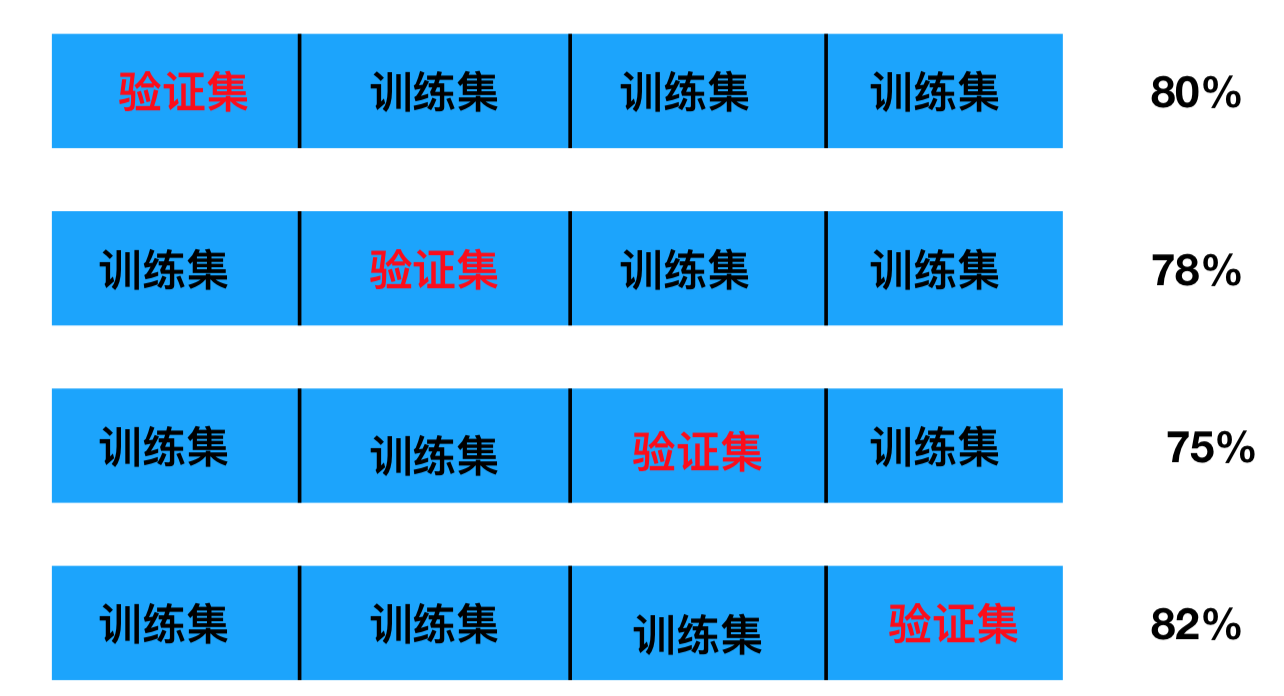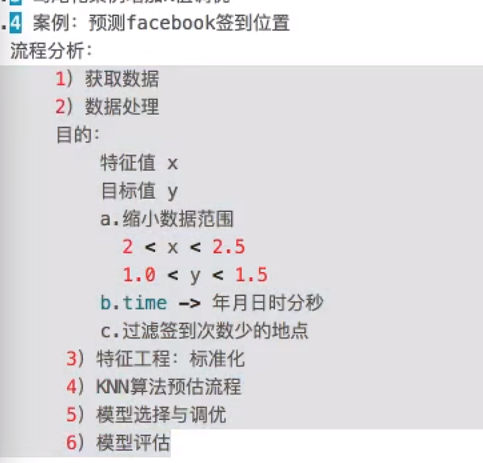3.3 模型选择和调优(KNN)
1.什么是交叉验证(cross validation)
交叉验证:将拿到的训练数据,分为训练和验证集。以下图为例:将数据分成5份,其中一份作为验证集。然后经过5次(组)的测试,每次都更换不同的验证集。即得到5组模型的结果,取平均值作为最终结果。又称5折交叉验证。
我们之前知道数据分为训练集和测试集,但是为了让从训练得到模型结果更加准确。做以下处理
训练集:训练集+验证集
测试集:测试集

2.超参数搜索-网格搜索(Grid Search)
通常情况下,有很多参数是需要手动指定的(如k-近邻算法中的K值),这种叫超参数。但是手动过程繁杂,所以需要对模型预设几种超参数组合。每组超参数都采用交叉验证来进行评估。最后选出最优参数组合建立模型。这个就是我们弄多个k值看看那个好的这一类问题的解决方法

3.模型选择与调优API
这里一个API既有网格搜索又有交叉验证
sklearn.model_selection.GridSearchCV(estimator, param_grid=None,cv=None)
- 对估计器的指定参数值进行详尽搜索
- estimator:估计器对象
- param_grid:估计器参数(dict)
- cv:指定几折交叉验证(一般10折)
- fit():输入训练数据
- score:准确率
- 结果分析:
最佳参数:best_params_
最佳结果:best_score_
最佳预估器:best_estimator_
交叉验证结果: cv_results_
4.鸢尾花k值调优
knn算法预估器
estimator=KNeighborsClassifier()
#加入网格搜素和验证
param_dict={"n_neighbors":[1,3,5,7,9,11]}
estimator=GridSearchCV(estimator,param_grid=param_dict,cv=10)
estimator.fit(x_train,y_train)
完整代码就是:
from sklearn.datasets import load_iris
from sklearn.model_selection import train_test_split
from sklearn.preprocessing import StandardScaler
from sklearn.neighbors import KNeighborsClassifier
from sklearn.model_selection import GridSearchCV
def knn_iris_gscv():
"""
用KNN算法对鸢尾花进行分类,使用网格搜素和交叉验证
:return:
"""
#1) 获取数据
iris = load_iris()
#2) 划分数据集
x_train,x_test,y_train,y_test=train_test_split(iris.data,iris.target,random_state=6)##数据集,目标集
##训练集特征值,测试集特征值,训练集目标集,测试集目标集
#3) 特征工程:标准化
transfer=StandardScaler()
x_train=transfer.fit_transform(x_train)
x_test=transfer.transform(x_test)#这时候只需要让测试集转化就行,没有必要计算,fit时计算过程,transform是转化
#4) knn算法预估器
estimator=KNeighborsClassifier()
#加入网格搜素和验证
param_dict={"n_neighbors":[1,3,5,7,9,11]}
estimator=GridSearchCV(estimator,param_grid=param_dict,cv=10)
estimator.fit(x_train,y_train)
#5) 模型评估
#方法1:直接对比真实值和预测值
y_predict=estimator.predict(x_test)
print("y_perdict:\n",y_predict)
print("直接比对真实值和预测值:\n",y_test==y_predict)
#方法2:计算准确率
score=estimator.score(x_test,y_test)
print("准确率:\n",score)
# 最佳参数:best_params_
print("最佳参数:\n", estimator.best_params_)
# 最佳结果:best_score_
print("最佳结果:\n", estimator.best_score_)
# 最佳估计器:best_estimator_
print("最佳估计器:\n", estimator.best_estimator_)
# 交叉验证结果:cv_results_
print("交叉验证结果:\n", estimator.cv_results_)
return None
5.预测facebook签到位置

def knncls():
"""
K近邻算法预测入住位置类别
:return:
"""
# 一、处理数据以及特征工程
# 1、读取收,缩小数据的范围
data = pd.read_csv("./data/FBlocation/train.csv")
# 数据逻辑筛选操作 df.query()
data = data.query("x > 1.0 & x < 1.25 & y > 2.5 & y < 2.75")
# 删除time这一列特征
data = data.drop(['time'], axis=1)
print(data)
# 删除入住次数少于三次位置
place_count = data.groupby('place_id').count()
tf = place_count[place_count.row_id > 3].reset_index()
data = data[data['place_id'].isin(tf.place_id)]
# 3、取出特征值和目标值
y = data['place_id']
# y = data[['place_id']]
x = data.drop(['place_id', 'row_id'], axis=1)
# 4、数据分割与特征工程?
# (1)、数据分割
x_train, x_test, y_train, y_test = train_test_split(x, y, test_size=0.3)
# (2)、标准化
std = StandardScaler()
# 队训练集进行标准化操作
x_train = std.fit_transform(x_train)
print(x_train)
# 进行测试集的标准化操作
x_test = std.fit_transform(x_test)
# 二、算法的输入训练预测
# K值:算法传入参数不定的值 理论上:k = 根号(样本数)
# K值:后面会使用参数调优方法,去轮流试出最好的参数[1,3,5,10,20,100,200]
# 使用网格搜索和交叉验证找到合适的参数
knn = KNeighborsClassifier()
param = {"n_neighbors": [3, 5, 10]}
gc = GridSearchCV(knn, param_grid=param, cv=2)
gc.fit(x_train, y_train)
print("选择了某个模型测试集当中预测的准确率为:", gc.score(x_test, y_test))
# 训练验证集的结果
print("在交叉验证当中验证的最好结果:", gc.best_score_)
print("gc选择了的模型K值是:", gc.best_estimator_)
print("每次交叉验证的结果为:", gc.cv_results_)



【推荐】国内首个AI IDE,深度理解中文开发场景,立即下载体验Trae
【推荐】编程新体验,更懂你的AI,立即体验豆包MarsCode编程助手
【推荐】抖音旗下AI助手豆包,你的智能百科全书,全免费不限次数
【推荐】轻量又高性能的 SSH 工具 IShell:AI 加持,快人一步
· Manus重磅发布:全球首款通用AI代理技术深度解析与实战指南
· 被坑几百块钱后,我竟然真的恢复了删除的微信聊天记录!
· 没有Manus邀请码?试试免邀请码的MGX或者开源的OpenManus吧
· 园子的第一款AI主题卫衣上架——"HELLO! HOW CAN I ASSIST YOU TODAY
· 【自荐】一款简洁、开源的在线白板工具 Drawnix